|
|
Updated as per James P. Tuttle's The Hawk Moths of North America, February 16, 2009
Updated as per personal communication with Pete (Smerinthus ophthalmica, March 22, 2014); March 23, 2014
|
Yuba County, California
Sphingidae
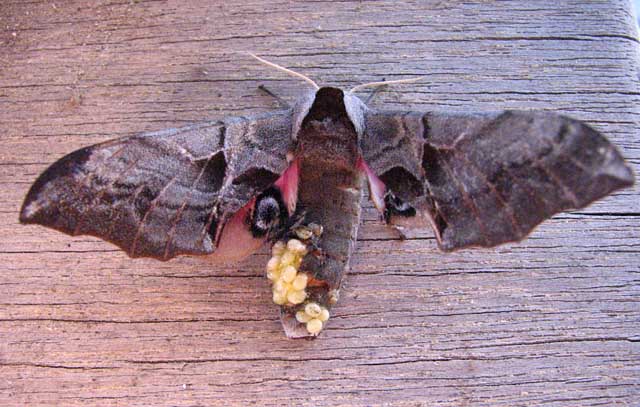
Smerinthus ophthalmica female, Marysville, Yuba County, California,
March 22, 2014, courtesy of Pete, id by Bill Oehlke.
Regarding the image directly above, Pete writes, "Found this moth and believe it's a one eyed sphinx by looking at picture on your site.
What can you tell me about the eggs (?) on its body, if anything, did something lay them there? I would be very interested in your answer.
"thank you, Pete"
I reply, "Pete,
"Perhaps a bird or cat attacked the moth and ruptured its abdomen so that the eggs were expelled or leaked out. It is doubtful that such eggs would be fertile as
the eggs usually get fertilized in the natural process of egg laying.
"There are many Smerinthus species, different ones in Europe and Asia from the three found in North America. Many of them are very similar. If you provide the
location of the sighting, I can probably id the moth or send you to a website where you can search the European or Asian species.
"Bill"
Pete indicated the moth is from Marysville, and I was able to identify it as Smerinthus ophthalmica which is very similar to, yet distinct from, the
one-eyed sphinx, Smerinthus cerisyi.
This page is dedicated to Stephen S. Miller
of Browns Valley (elevation 500 feet), Yuba County, California, for his abiding interest in Lepidoptera.
Many thanks also to Brandi Lanini Murray who has documented a sighting of Eumorpha achemon in Marysville.
Thirty-two Sphingidae species are listed in the USGS for California. Not all of the species are reported by the USGS for Yuba.
(One species, the Snowberry clearwing (Hemaris diffinis, more likely Hemaris thetis) is listed by the USGS for Yuba County.)
Steve Miller confirms that Smerinthus cerisyi (more likely Smerinthus ophthalmica) is also present as are
Hyles lineata, Manduca sexta (possibly as a stray), Pachysphinx occidentalis, Sphinx perelegans, Eumorpha achemon and Sphinx chersis.
It is hoped that this checklist, with the thumbnails and notes, will help you quickly identify the moths you have encountered.
A WO" after the species name indicates that I have no confirmed reports of this species in your county, but I
(William Oehlke) expect that this moth is present.
A USGS indicates the moth is reported on the USGS website and/or in Moths of Western
North America, #2. Distribution of Sphingidae of Western North America, revised, an excellent little booklet available through Paul Opler.
Please help me develop this list with improved, documented accuracy by sending sightings (species, date, location), preferably with an
image, via email to Bill Oehlke.
More sophisticated tools (especially DNA barcoding analysis) have been developed to differentiate between species. Testing results show that the moths west of the
Continental Divide, previously identified as Smerinthus cerisy and Hemaris diffinis are much more likely to be
Smerinthus ophthalmica and Hemaris thetis, respectively. The moth formerly identified as Arctonotus lucidus has now been assigned to the
Proserpinus genus as Proserpinus lucidus.
Data and images previously hosted on USGS now resides on more accurate and current BAMONA website.
Sphinginae subfamily
Sphingini tribe:
 |
Manduca quinquemaculatus
WO, the Five-spotted Hawkmoth:
This large bodied moth flies in tobacco fields and vegetable gardens
(potatoes, tomatoes) and wherever host plants are found. |
 |
Manduca sexta
SM, the Carolina Sphinx:
This species is reported by Stephen Miller.
If you grow tomatoes, you have probably encountered it.
Larvae get very large and can strip a tomato plant. Generally its breeding ground is further south.
It will be interesting if larvae are encountered. |
 |
Sphinx chersis
SM, the Northern Ash
Sphinx or Great Ash Sphinx: The upperside of the forewing is soft dark-gray to blue-gray with
a series of black dashes, one reaching the wing tip. Note grey
thorax with narrow black lines.
|
 |
Sphinx drupiferarum
WO,
the Wild Cherry Sphinx:
Forewings, long and slender, are held close to the body when the moth
is at rest.
I only see them occasionally on P.E.I. despite visiting lights
frequently. |
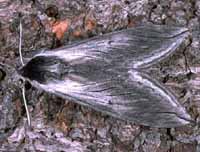 |
Sphinx perelegans
SM, the Elegant Sphinx:
Sphinx perelegans adults fly in montane woodlands and mixed chaparral-type vegetation as a single brood
in the north, with adults mainly on the wing in June and July.
It flies from dusk until after midnight. Note dark thorax. |
 |
Sphinx vashti
WO, the Snowberry Sphinx:
The upperside of the forewing has a narrow black subterminal line
bordered by a white inverted V-shaped line on the outside, and a
black line running inwards from the apex of the wing.
It is most often found in montane woodlands and along streamcourses.
|
Smerinthini Tribe:
 |
Pachysphinx occidentalis
SM,
the Big Poplar Sphinx:
This one is quite similar to Pachysphinx modesta, with modesta
being smaller and darker.
Moths should be on the wing from June-August.
|
 |
Paonias excaecata
WO, the Blinded Sphinx:
The grey-blue eyespot (without a black center pupil) of the hindwing gives this species its name.
Larvae feed on birches, willows, cherries and oaks.
The outer edge of the forewings is quite scalloped. |
 |
Paonias myops WO,
the Small-eyed Sphinx:
This small species might be present. This species ranges across North
America.
The hindwings have a small blue eyespot ringed with black on a yellow
background.
|
 |
Smerinthus cerisyi
doubtful, the Cerisyi's
Sphinx or One-eyed Sphinx: Larvae feed on poplars and willows.
Flight would be from late May-July as a single brood. probably replace by ophthalmica
|
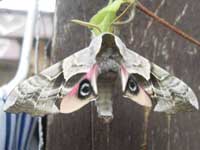 |
Smerinthus opthalmica
SSM/Pete: Larvae feed on poplars, aspen and willows.
Note different shape of double arced forewing pm line compared to the straighter pm line of cerisyi, directly above.
S. ophthalmica has smoother scalloping of the fw outer margin.
|
Smerinthus ophthalmica, Marysville, Yuba County, March 22, 2014, Pete
Macroglossinae subfamily
Dilophonotini Tribe:
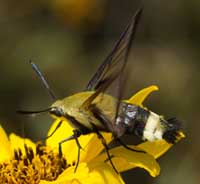 |
Hemaris thetis USGS, the Thetis Clearwing or Bee Hawk Moth:
The moth flies along forest edges and in meadows, gardens and
brushy fields. Day-flying adults nectar at lantana, dwarf bush honeysuckle,
snowberry, orange hawkweed, thistles, lilac, Canada violet, etc.
|
Philampelini Tribe:
 |
Eumorpha achemon
SM/BLM,
the Achemon Sphinx:
This moth is now recorded for Yuba County,
and it should be present wherever grapes are found.
Flight would be from June to August. Larvae feed on grape foliage. |
Eumorpha achemon, Marysville, August 1, 2011, Brandi Lanini Murray
Macroglossini Tribe:
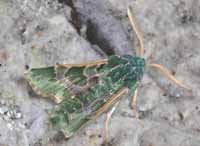 |
Proserpinus lucidus
PH/WO, the Pacific Green
Sphinx Moth or Bear Sphinx: This species is confirmed in nearby Butte
County by Patience Hervey, December 29-30, 2005.
It tends to be
an early winter-early spring flier, on the wing in the early evening. It comes to lights at night. |
 |
Hyles lineata
SM,
the White-lined Sphinx:
Adults usually fly at dusk, during the night, at dawn, and during the
day. Moths nectar at salvia and oviposit on Epilobium cana
(California fuchsia) and Hooker's Evening Primrose. |
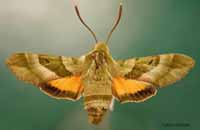 |
Proserpinus clarkiae
WO, Clark's Sphinx:
Adults fly in the afternoon from April-June in oak woodland and
pine-oak woodland in foothills, nectaring from chia, heartleaf
milkweed, golden currant, bluedicks, fairyfans, vetches,
thistles, hedgenettles, etc. |
|
|
Enjoy some of nature's wonderments, giant silk moth cocoons.
These cocoons are for sale winter and fall. Beautiful Saturniidae moths will emerge the following spring and summer.
Read Actias luna rearing article. Additional online help available.
Use your browser "Back" button to return to the previous page.
This page is brought to you by
Bill Oehlke and the
WLSS. Pages are on space rented from Bizland. If you would like
to become a "Patron of the Sphingidae Site", contact Bill.
Please send sightings/images to Bill. I will do my best to respond to
requests for identification help.
 | 
Show appreciation for this site by clicking on flashing butterfly to the left.
The link will take you to a page with links to many insect sites. |


